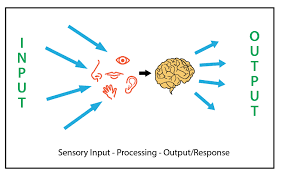
Sensory processing disorder (SPD) is a fairly new disorder that has been discovered. Having been unearthed in only the past 50 years (Byrne), sensory processing disorder is characterized by being overstimulated by occurrences that one may not typically be disturbed by. It is a condition that influences the way that one’s mind interprets stimuli. Seeing that the condition has only in recent years been found, not many individuals believe that further research on SPD is necessary. This mindset, however, is very harmful. About 5% of the general population is presumed to have at least some form of sensory processing disorder (Understanding Sensory Processing Disorder). The more educated people are on SPD, the more society will improve as humanity will have a better understanding of one another.
The first concept of sensory processing disorder was established in 1972 as the sensory integration theory by Dr. Jean Ayers (Sensory Integration Theory & Sensory Processing: What’s the Difference?). While working with children as a therapist, she had noticed the inconsistent ways that children reacted to different sensory aspects. Although Dr. Ayers is credited with the discovery of SPD, her protégé Dr. Miller was the one who coined the term sensory processing disorder in 2006 (Sensory Integration Theory & Sensory Processing: What’s the Difference?). Miller built upon the work of her mentor and made Dr. Ayers theories and ideas much easier for the general public to consume. In the 1980’s and 1990’s, the disorder and its treatments began to be questioned. Academic authors started to discredit Dr. Ayers, challenging the legitimacy of her revelation. However, their unpleasant inquiries were quickly dismissed as the studies they based their findings on were found to be heavily flawed. The road for SPD to be recognized as a true medical diagnosis is long and challenging but the increase in research after those years of hardships make it all the more significant.
Sensory processing disorder is a neurological disorder. With neurological disorders, the foundation of research is built upon quicksand. One new discovery can influence every aspect of the way the disease is handled. As with many other neurological disorders such as attention deficit hyperactivity disorder (ADHD), autism, and dyspraxia, the causes of SPD remain largely undetermined. This however, does not mean that there are no theories as to how this condition is developed. Many scientists are drawn to the same conclusion that SPD is a hereditary disorder, one that is passed on throughout the generations (Sensory Processing Disorder). This is supported by studies that demonstrate parents who have SPD are more likely to give birth to children with SPD. Other theories are that sensory processing disorder is caused by some interruption in a child’s early life. This is exemplified by traumas such as premature birth and brain injuries (Sensory Processing Disorder). The disturbance is believed to cause some form of minor brain damage that affects the way that one’s mind is able to comprehend different stimuli around them. The speculation with the least support is that sensory processing disorder is brought upon by fetal alcohol spectrum disorder (FASD), a series of disorders that can potentially develop if one’s mother consumed alcohol during her pregnancy (Jirikowic). The primary reason that this claim holds so little value is because of how there has been virtually no studies to back it up. Any disorder that affects one’s development can be linked to fetal alcohol spectrum disorder. More research will need to be done before this claim can be seen of any significance. Many ideas arise as to what is the true cause of sensory processing disorder but until further experimentation is conducted, there will be no solid answer.
In the world of disorders, there is no “one size fits all“. Each individual experiences different symptoms that drastically affect the way they see the world around them. These inconsistencies are the primary perpetrators of the lack of information around neurological disorders. Sensory processing disorder can present itself in numerous different ways. As in the name, sensory processing disorder affects one’s senses. While some may only find themselves to be affected in one way (ex. Only being sensitive to smells), others may experience a much more intense version of SPD if several of their senses are influenced. For those people, attempting to focus on what’s around them can be debilitating. Nevertheless, a pattern was able to be found. On the touch side of SPD, one may find themselves to be more impacted by the way clothes feel against their skin (It Is a Sensory Issue? Symptoms and Signs of Sensory Issues in Children). For the audio part of SPD, children are often observed to be immensely distressed by high pitched or repetitive noises (Sensory Processing Disorder). Furthermore, those who have their vision affected may be irritated by lights or even certain shades of colors. This can be particularly difficult as the only way to improve the situation is to leave and that is not always an option. Arguably the most tiresome stimuli to deal with is one’s sense of smell. It is the most difficult circumstance to change and there are few ways to ignore it. This is also the most personalized for one to deal with. For each person experiencing SPD, smells that aggravate them can be entirely different. There is no method to decipher why one smell can send someone into a frenzy. Lastly, another very personalized stimulus is the way one consumes food. Even those without sensory processing disorder fall victim to eating habits based on the way their brain interprets the food’s texture. Individuals with SPD are commonly dubbed as being picky eaters as they are repulsed by food that does not have a texture that is ideal to them. Symptoms of sensory processing disorder manifest much differently in adults than in children. While most adults retain at least some form of their childhood stimuli aversions, as they mature they may run into further obstacles. Individuals might find themselves withdrawn from physical contact or difficulty planning and keeping ideas straight (Sensory Integration Theory & Sensory Processing: What’s the Difference?). As one enters adulthood, these once seemingly small hindrances become amplified. The inability to keep one’s life organized can be daunting and overwhelming. Growing up in an environment in which one is overburdened by society’s antics can lead to anxiety and depressive disorders such as obsessive-compulsive disorder (OCD), post-traumatic stress disorder (PTSD), and major depressive disorder (MDD). For every individual, SPD exhibits itself in a manner that may be contradictory to other people with sensory processing disorder.
To some, 50 years may seem to be a long period of time. However, in the medical world, this is a small portion of time. The treatments for sensory processing disorder have not had enough time to further evolve into the most effective method of itself. That being said, the treatments offered to the public are still of high value and can dramatically change peoples lives. The most common and socially-acceptable way to help those with sensory processing disorder is by having them go to an occupational therapist. With the assistance of occupational therapist, many people with SPD are able to overcome the once formidable hurdles that blocked them from leading a normal life (Rodden). The pioneer of the research for sensory processing disorder, Dr. Jeans Ayers’ (previously mentioned) method of proactive treatment is still being used to this day. Her method of sensory integration (SI) does not focus on the disorder itself but instead on the other parts of the mind and body that sensory processing disorder affects (Rodden). One example of this is instead of trying to stop one from being unsteady as whole (better known as dyspraxia), focus on a part of the unsteadiness such as the person’s way of walking or writing. By working with people in small, manageable portions, they are able to reach success without feeling as though their efforts are amounting to nothing. In more severe cases of sensory processing disorder, speech therapy may be needed (Rodden). Many people with SPD may also choose to pair up therapy with alternative medical treatments such as acupuncture. Howbeit, it is never suggested to experiment with pharmaceuticals in an effort to rid oneself of sensory processing disorder. Not only that it doesn’t work, but it is also incredibly dangerous to try to cure something believed to be incurable with medication that is not prescribed for that condition. Another frequently used management technique is just basic self care. If one knows that they will be placed into a situation that will make them uneasy and overwhelmed, they can do things to help reduce that level of stress. This might include things such as bringing earplugs and wearing clothes they know will not make them uncomfortable. Avoiding seemingly unbearable circumstances just is not realistic. The best thing that individuals with sensory processing disorder can do for themselves is to make the affair they have to attend become a more tolerable experience.
Furthering one’s personal understanding of how difficult living with sensory processing disorder is allows society as a whole to become more understanding and empathetic. Neurological conditions are not easy for people to live with and those without them will never be able to truly understand how it is. It is important for the community to try to see from the eyes of their neighbors as diseases without physical ailment are usually overlooked. Many people underestimate the way that sensory processing disorder can affect the development of children. It is necessary to not sympathize with them but ever so acknowledge the struggle that they may face. It is of paramount importance that one educates themselves about mental health disorders so they can appreciate the world around them and the people in it.
Bibliography
Byrne. W Mary. (2009). Sensory processing disorder: Any of a nurse practitioner’s business?. , 21(6), 314–321. doi:10.1111/j.1745-7599.2009.00417.x
“It Is a Sensory Issue? Symptoms and Signs of Sensory Issues in Children -.” GriffinOT, 4 Nov. 2021, www.griffinot.com/sensory-issues-symptoms-and-checklists/.
Jirikowic, Tracy; Olson, Heather Carmichael; Kartin, Deborah (2008). Sensory Processing, School Performance, and Adaptive Behavior of Young School-Age Children with Fetal Alcohol Spectrum Disorders. Physical & Occupational Therapy in Pediatrics, 28(2), 117–136. doi:10.1080/01942630802031800
Rodden, Janice. “How to Treat Sensory Processing Disorder.” ADDitude, ADDitude, 20 July 2021, https://www.additudemag.com/sensory-processing-disorder-treatment/.
Rudy, Lisa Jo. “Autism, Sensory Processing Disorder, and Sensory Integration.” Verywell Health, https://www.verywellhealth.com/what-is-sensory-processing-disorder-260517. >
“Sensory Integration Theory & Sensory Processing: What’s the Difference?” GriffinOT, 29 Nov. 2021, www.griffinot.com/sensory-integration-sensory-processing/.
“Sensory Processing Disorder.” Sensory Processing Disorder | Michigan Medicine, www.uofmhealth.org/health-library/te7831.
“Understanding Sensory Processing Disorder.” Sensory Processing – STAR Institute, sensoryhealth.org/basic/understanding-sensory-processing-disorder.







